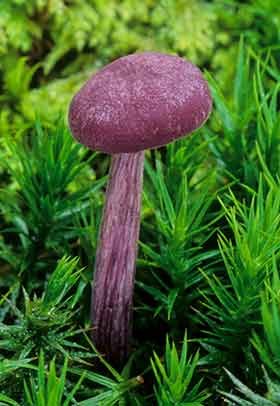Amethyst Deceiver (Laccaria amethystea)

resplendent within a bed of moss
The Amethyst Deceiver is relatively common and widespread throughout many New Forest woodlands, particularly ancient, unenclosed beech woods where the soil has for many years remained relatively undisturbed.
Once known as the Amethyst Agaric, the Amethyst Deceiver's strikingly purple, violet or lilac colouration recalls that of the precious stone that gave it part of its name. The colour, however, tends to fade with age and may vary depending upon moisture content, which is said by some to explain the derivation of the 'deceiver' element of the name.
Amethyst Deceiver fruiting bodies, found throughout the autumn, typically grow to a height of 4 - 10 centimetres. The cap, from 1 - 5 centimetres across, is initially of convex shape - as illustrated - but with age often flattens, becomes centrally depressed and develops a wavy margin. The gills are usually well-spaced and are always of similar colour to the cap and stem.
One of the most straight-forward fungi to identify - colour is clearly a major clue - the Amethyst Deceiver is edible and is said to be quite good.
Warning: refer to a good, comprehensive fungus field guide to confirm identification, and only eat those species known without any doubt whatsoever to be edible - people have died after eating certain poisonous specimens.
References:
Mushrooms and other Fungi of Great Britain and Europe - Roger Phillips
The Mushrooms and Toadstools of Britain and North-western Europe - Marcel Bon
Fungi of Britain and Europe - Stefan Buczacki and John Wilkinson
The MacDonald Encyclopedia of Mushrooms and Toadstools - Giovanni Pacioni
Fungi of the New Forest: A Mycota - Edited by Gordon Dickson and Ann Leonard
A Passion for Mushrooms - Antonio Carluccio
More links
Other related links
Search this site

Sadly, 58 animals were killed - 35 ponies, 13 cows, 8 donkeys and 2 sheep, whilst a further 32 were injured - 3 pigs, 9 donkeys, 11 cows and 9 ponies.
(Forty-three accidents occurred in daylight, 15 at twilight and 101 in the dark. Twenty-seven accidents were not reported by the driver involved).
Here's just one horrific example - Three donkeys killed in collision with van at notorious New Forest blackspot (Advertiser and Times)

